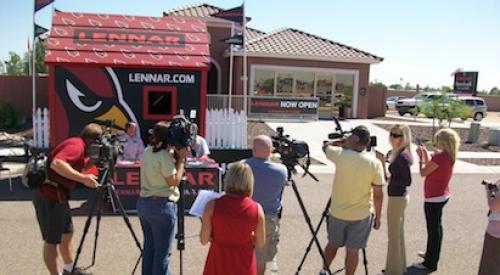"Permission" marketing is not really new, but it is substantially different from the billboards and radio ads of traditional new home marketing. The key to making permission marketing work is a good Web site.
With a strong online presence, builders can ask shoppers to "click here" to gain permission to open an on-going dialogue — well ahead of grand opening model homes at the builder's next community. That allows the builder to create anticipation for a new product and location that sometimes approaches buyer frenzy.
In the old days, permission marketers used direct mail and the telephone to identify and stay in touch with prospects over a long period of time. Web sites and e-mail are not only a lot more efficient, but cheaper as well.
The permission marketing concept takes "pre-selling" — at reduced prices — right out of the picture. "We saw very low option and upgrade sales when we used to pre-sell," says John Laing Homes executive vice president of sales and marketing Bill Probert, an outspoken advocate of permission marketing. "When you don't have the model homes to demonstrate the appeal of those upgrades, you end up with sales revenues that are 2 percent to 5 percent lower. Why do that?"
Benefits of PermissionPermission marketers offer some sort of benefit to prospects for lining up ahead of the grand opening — a discount, a better lot, a package of upgrades — but those "costs" are offset by the increased pricing power represented in a strong model home presentation. When the grand opening weekend finally comes, the builder realizes a host of benefits:
- Intensified demand
- Greater sales momentum
- Improved profits
- Enhanced marketing flexibility
- Increased customer satisfaction
Bowen Family Homes' Stonehaven Pointe in the Atlanta suburb of Cumming, Ga., is an example of what permission marketing can accomplish. The firm opened three furnished, arts-and-crafts style model homes on the weekend of February 11, at an event attended by 200 prospects, 30 of which camped overnight in line. Bowen coddled them through weeks of online contact to get them there, and ended the weekend with 65 contracts for single-family homes ranging from 1850 to 2300 square feet and priced from $160,000 to $220,000.
Stonehaven Pointe will eventually have 480 detached and 190 attached homes, and it's now off to a roaring start toward a fast build-out.
In this case, Bowen used traditional marketing media to reinforce the success of its permission marketing program. The firm ran a series of newspaper ads pointing out the growth of its interest list for the community. "When people realize others are also waiting for homes, demand intensifies," says Kelly Fink, Bowen's regional marketing director. "However, prospects need to have confidence that their place on your priority list is secure, so they don't decide to buy elsewhere."
This reinforces a point often made by noted new home marketing consultant Stan Kates of Toronto, Canada: "People buy real estate when they see other people buying real estate!" People want what they can't have, Kates says. Human nature intensifies demand. And, if the permission marketing program begins far enough in advance of actual construction, a builder can even tailor the final product to the wants and needs of the prospects on the priority marketing list.
Probert says these advantages are reflected on the bottom line: "We think we make 2, 3, 4 percent more by holding off sales, building demand, then grand-opening model homes that demonstrate the enhanced lifestyle we've been telling prospects about."
The costs of maintaining an online marketing program are more than offset by increased option and upgrade sales. And any reluctance builders have about delaying the revenue stream associated with pre-sales is blown away by the impact of a blowout opening weekend. Success stories for permission marketing are now showing up all over the country, even in otherwise slow markets. Probert says it works for Laing in Colorado as well as California.
Customer satisfaction also builds steadily from the first contact because shoppers appreciate the way constant communication overcomes the stress associated with buying a home. Even in a hot market, where everything sells fast, the builder reaps benefits from maintaining a consistent flow of information. "It's what the customer deserves," says Probert. To do less would be inconsistent with the brand Laing is building around its Web site.
Every element of marketing that carries the Laing name also carries its Web address.
Concerned Builders Want To Know . . .Many builders worry that without pre-sales, buyers may be lost to the next new project that opens down the street. That's always a risk, but how do you know those buyers who would jump would not do so even if they'd signed a pre-sales contract?
Probert says pre-sales dilute momentum, and an effective grand opening weekend more than offsets revenue lost by passing up pre-sales. But before you jump into permission marketing, remember that grand opening events can still have the negative impact of leaving money on the table — if you sell too far in advance of your ability to deliver homes at the closing table.
You need balance: Too many opening sales and you lose pricing power, too few and you lose sales momentum. The process has to fit your culture, brand, resources, and the community being marketed. Once you know how — and when — you want to touch the customer, adding automation to the Web site to facilitate the permission marketing process is easy. Your first attempt may not be perfect, but you can tweak the system as you learn what works best for you. The important thing is to get started, and put a process in place that's repeatable.
Here are a few success stories to whet your appetite for getting closer to your prospects:
Laing Has PermissionProfessional Builder's 2004 Builder of the Year, John Laing Homes, builds its whole marketing approach around a permission marketing program it calls John Laing Advantage. Bill Probert points out that Laing operates in many of this country's hottest housing markets, including Southern California, where builders and their sales teams are often cavalier about how they handle leads and prospects.
"Our industry is cyclical in its view of the importance of treating the customer well," Probert says, expressing frustration at the way customer care deteriorates when the market is strong. "If you're going to have people out there, they should be prepared to treat customers the way we would all like to be treated, all the time," Probert says. "Larry Webb (Laing CEO) has really set the tone for our approach to caring about people."
Probert does not mince words about his attitude toward pre-selling: "I don't believe it works," he says. One Laing division asked to open sales several weeks before models were complete. "Why would you want to show the bride — in her curlers, with no makeup — when a few weeks from now you can show her off in all her wedding day glory?" he asked.
Probert says his approach is to build a relationship with customers, over time, that he likens to dating. "We want to get a second date, then a third and fourth. When I look at the direct mail pieces that many builders send out, I question whether people even open them. We want to think about how we can make our communications more personal and relevant."
Laing gets lots of leads, but not all from people who are urgently in the market. "The people who are not ready to buy now do not want to talk to a sales person," Probert says. So Laing made a significant commitment to Web technology to break up its leads, so it can treat each group the way those prospects want to be treated. "We break them into A and B categories," Probert says. "At any time, 10 to 20 percent of the market will buy something in 30 to 60 days. That's the A category. They will give us permission for closer contact.
"The goal is to pique their interest," Probert reasons. "We give them just enough information to satisfy them that they want to know more." He likens the relationship to that of a patient and doctor. "If you give them everything, then they're cured and your relationship with them is done." Instead, Laing asks how it can solve the prospect's housing problem. "We ask them to picture themselves living in our community, building their lives, their dreams," Probert says. "The goal of all this initial communication is to get the highest quality prospects to give us a higher level of permission. Once they respond by joining our Advantage program, they go into a personal communication pathway."
What about the 85 percent of prospects who are not ready to join the Advantage program? "We still have them on an automated communication program that looks like it's personal," Probert says. "That's what we call 'cultivating.' We're farmers."
D.R. Horton Comes Up For Air In A Hot MarketCentral Florida is red hot. For D.R. Horton's local marketing team, headed by Jack Appleman, vice president, sales and marketing, and Natalie Lambert, marketing coordinator, just keeping up with demand is a challenge. Horton isn't daunted, though. The company has a Web site and marketing approach tailored to how customers are shopping for homes.
"Eighty to 90 percent of our buyers have been on our Web site," Appleman says. "Technology has forced us to play smarter. We are now more prepared as we do our phase releases."
Five years ago, Horton was not in the top 10 builders in Orlando. This year, the firm will do between 1800 and 1900 closings, good enough to compete for the top spot.
Many are now calling Florida "the new California," and local housing markets reflect the similarity. For instance, Horton is now pre-planning floor plans and elevations across a whole community. The firm has also developed an effective program to handle "A" prospects with kid gloves through a high volume of phased lot releases.
Appleman thinks the pre-planning helps to improve the production rate and control costs. "We pre-plan the homes and elevations," he says, "then we also pre-select the external color schemes and interiors packages. The home is all put together — on paper — when the customer comes in."
Are the consumers happy? "They like the fact we've taken all the guesswork out of the process for them. We put the sizzle where they want it. We tell them, 'Our design professionals are going to do it for you and you'll be very pleased with the outcome.'"
Lambert uses an automated system to track and manage home buyers through the entire marketing process. "We have increased the number of events we hold and decreased the size of our lot releases," she says. This allows Horton to sell closer to closing dates, which reduces cost risk and minimizes the chance of leaving pricing dollars on the table.
Like all smart permission marketers, Horton uses automated technology to manage lists of prospects, rather than promote individual communities one by one. By aggregating demand through its "VIP program," Horton believes it does a better job of managing customer expectations. "We send a teaser campaign 30 days before the opening of a community, with very specific information," Lambert says. Included are details about deposits required, investor restrictions (an increasingly touchy subject) and Realtor involvement.
Small phases work best, Lambert says. "We are not the kind of builder that wants to sell 500 homes in a day. When you release 150 home sites at one time, you lose the personal touch."
Horton refuses to allow Orlando sales to get too far ahead of production, and the fact that so many selections and color choices are pre-planned helps. Appleman says most homes start as specs and are well into framing by the time they sell. Thirty home sites is the typical size of a release phase.
"We do an e-mail blast 10 to 14 days in advance of the release," Lambert says, "and we go three deep on each lot. If we are selling 30 home sites, we will give a lottery number to 90 people. They pre-qualify that day. Those that don't buy go onto a priority reservation list for later releases."
Those that don't make it to the closing table become qualified and motivated buyers for future releases.
Bowen's Accidental PandemoniumAtlanta-based Bowen Family Homes literally stumbled into a new process for handling grand openings in February of 2004 at a community called Breckinridge Station, where the firm eventually had 398 homes to sell. Bowen opened with 75 homes sold on the first weekend, but it was a struggle.
Randall Moore, vice president of sales, relates that bad weather caused numerous delays, so as the date to open sales approached, the site was not ready. But the firm had its Web site up and was taking calls from interested prospects. "We were just not ready for sales," Moore says today, "so the interest list grew.
"This was the first time we ever waited until the models were complete before opening," he says. "Before, we were always of a mind that as soon as we could get a temporary office on site, we were open for business. But in this case, as we were building the models, people began calling. We were handling all these inquiries, and people wanted to buy right then and there. We accidentally created pandemonium, but we were smart enough to see, after the fact, that we'd stumbled on a better way to open a community."
With its next community, Shadowbrook, Bowen decided to hold off sales and develop what happened at Breckinridge into a standard process. "Not everyone thought that was a good idea," says regional marketing director Kelly Fink. Again, Bowen saw its interest lists growing, but in July of 2004, it opened the community by selling 40 of 85 home sites on the first weekend.
Stonehaven Pointe was next. In this case, Bowen has more than 600 homes to sell, so the firm ran newspaper ads and put up three billboards. But there were no pre-sales, no lot deposits. The newspaper ads reported the increase in the size of the interest list as it grew from 100 to 300 names. Bowen managed the interest list by sending out multiple e-mail blasts.
By the time of the grand opening in February this year, people were camping out on the site despite freezing weather. Some 65 houses sold that weekend. Did Bowen leave money on the table? "We separated sales into pods of 20 units," says Moore. "Each pod was priced at a different level. So while it's not pricing at the closing table, we're happy with how it worked out."
High Tech, High TouchIrvine, Calif.-based MBK Homes has a refined preferred buyer program it calls "Very Important Buyer" — VIB. It is a priority registry of buyers eligible for sales release events the firm holds. The goal is to eliminate camp-outs and improve the customer experience.
Jeanne Stott, senior vice president of sales and marketing, designed the system. She says it has great benefits, but believes such programs must be tailored to the builder. "It has to fit the culture," she says.
Getting customers interested enough to sign up is a challenge, she admits. To be a VIB member, customers have to complete an online application and go through pre-qualification with a preferred lender. Stott says builders should design their programs from the perspective of their customers. "What does the customer gain?" she asks.
In the case of VIB, customers get a priority number online when they complete the application. They know they will be invited to exclusive sales events and get preference in home selections. When Stott looked at it from the point of view of the customer, she saw it was important for MBK to provide a priority number as the carrot in the process. To get to that, she had to add online pre-qualification capability.
MBK had to make a significant investment in online technology to make the program work — it's a unique blend of high-tech and high-touch. When someone opts into becoming a lead, that person is on a communications path. Once the lead goes a step further to become a VIB, invitation to a set of events kicks in. The system informs on-site new home consultants of new VIB members who join each day. The agents call to further qualify the prospects. Then they turn the prospective buyer over to a mortgage officer for the next step. He or she confirms the information from pre-qualifications. MBK makes a series of small commitments and then executes on those commitments. "It's all about building relationship and trust," Stott says.
While buyers have a few hoops to jump through, they can be confident they know the rules and that those rules are fair. She says this system is, above all, customer-oriented and fair. Our VIB customers are kept well informed and feel very important," says Stott of the VIB program.
Aside from improving levels of customer satisfaction, MBK learned the VIB program also gives the firm marketing flexibility when sales rate expectations were not achieved. A community called Altoliva at Tesoro in the Santa Clarita Valley is a case in point.
MBK had 500 people on a VIB list at a nearby community called Valencia, but Altoliva was in a different school district, and its performance fell short of expectations. So MBK pulled out all the stops to market the new community, then went to work on the VIB list from Valencia. By leveraging that list, MBK was able to recover fast. But without the ready pool of interested customers on the Valencia VIB list, recovery might not have happened.
Stott and the rest of the marketing team might have grown a few gray hairs.
| Author Information |
| Blair Kuhnen is a partner at Web site and marketing system developer Realty InfoLinks in Dallas, Texas. He can be reached at 972-661-1975 or via e-mail at blair@realtyinfolinks.com. |












